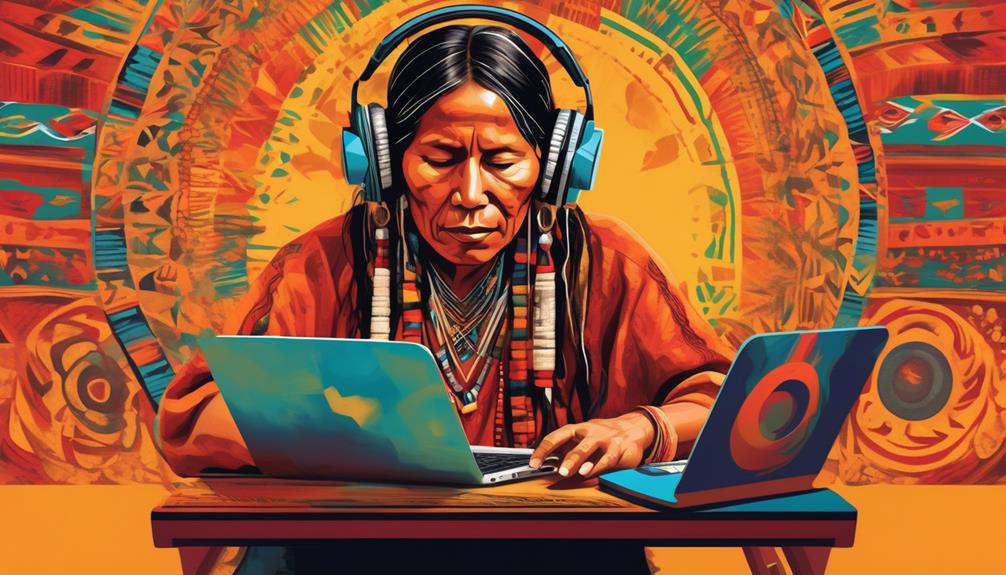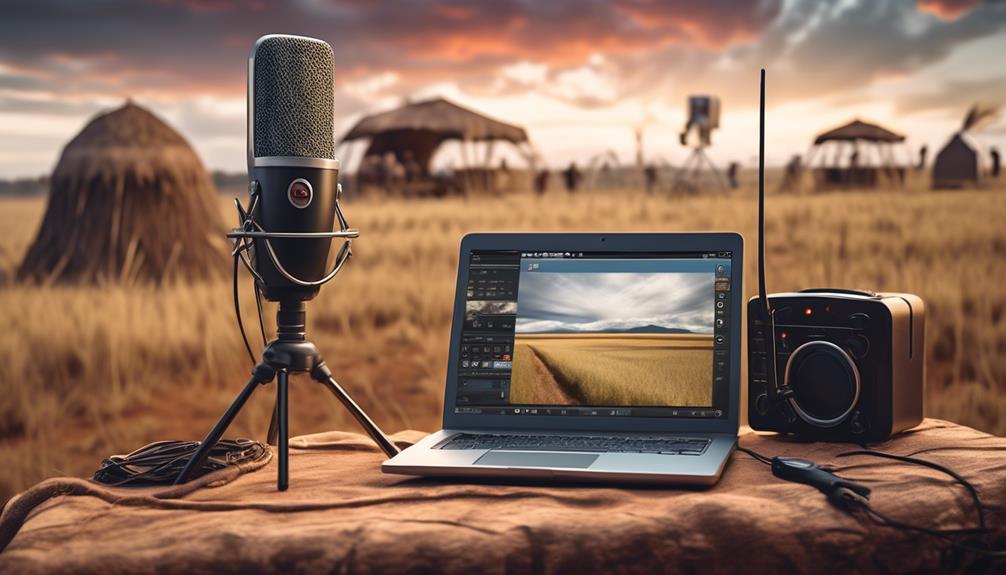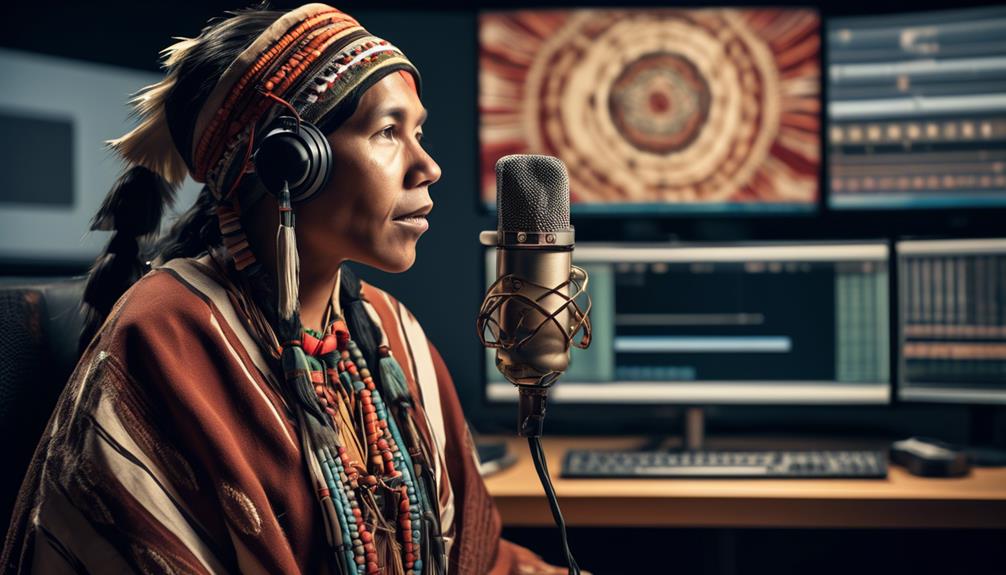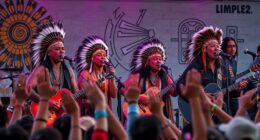As we explore the vast world of indigenous languages through radio and the internet, it becomes apparent that these platforms play a vital role in maintaining and revitalizing linguistic diversity.
The intertwining of traditional oral storytelling with modern digital mediums has sparked a new chapter in the ongoing narrative of indigenous language preservation.
However, as we navigate through the complexities of this landscape, it's essential to uncover the opportunities and challenges that lie ahead.
Key Takeaways
- Preserving indigenous languages through radio and online platforms is crucial for maintaining cultural identity and promoting linguistic diversity within communities.
- Digital platforms provide broader access to indigenous language resources and learning materials, fostering language learning and revitalization.
- Limited allocation of time for indigenous language broadcasting hinders the preservation and promotion of indigenous languages.
- Community-run broadcasting initiatives have demonstrated the potential for supporting indigenous languages through local radio stations.
Importance of Indigenous Language Preservation
Preserving indigenous languages through radio and online platforms is crucial for maintaining cultural identity and promoting linguistic diversity within our communities. Indigenous language radio stations play a vital role in this endeavor, especially in rural areas where access to other forms of media may be limited. These community radio stations serve as a platform for the revitalization and preservation of indigenous languages, allowing Indigenous Peoples to reclaim and celebrate their local languages. By broadcasting stories, traditions, and knowledge in indigenous languages, these stations contribute to the continued existence and relevance of these languages within our communities.
However, the support for indigenous radios varies across different countries, impacting the reach and impact of these stations. National policies play a significant role in either supporting or impeding the resurgence and representation of indigenous languages in broadcasting. Challenges such as the lack of indigenous language professionals and limited airtime allocation also contribute to the struggle of indigenous language broadcasting and preservation.
Despite these challenges, the importance of preserving indigenous languages through community radio stations remains paramount for the cultural identity and linguistic diversity of our communities.
Impact of Digital Platforms on Language Revitalization

The importance of preserving indigenous languages through community radio stations extends to the impact of digital platforms on language revitalization. Digital platforms significantly influence the revitalization of indigenous languages by providing new avenues for access, preservation, and promotion. Through research and development, digital platforms are increasingly leveraging AI-driven recommendations to connect indigenous language speakers with relevant content, thus fostering language learning and revitalization. The following table highlights the key impacts of digital platforms on language revitalization:
| Impact | Description | Example |
|---|---|---|
| Access | Digital platforms provide broader access to indigenous language resources and learning materials. | Online language learning apps and courses |
| Preservation | Online platforms aid in preserving and archiving traditional indigenous language materials. | Digitized recordings, texts, and oral histories |
| Promotion and Outreach | Social media and online communities facilitate the promotion of indigenous languages. | Indigenous language content on podcasting platforms |
Challenges Faced by Indigenous Communities
Facing limited allocation of time for indigenous language broadcasting by the National Broadcasting Commission, indigenous communities encounter significant challenges in preserving and promoting their languages. The lack of indigenous language professionals and linguists in broadcast stations further exacerbates these hurdles. The high prestige of the English language as the official language overshadows indigenous languages, making it difficult for them to thrive in the electronic media landscape. Indigenous languages only occupy a small percentage of the broadcasting time, hindering their visibility and accessibility to wider audiences. Additionally, multilingual societies struggle to effectively promote and preserve their indigenous languages in the face of these challenges.
Furthermore, the difficulty in accessing relevant research and new content alerts for indigenous languages poses a significant barrier. Indigenous communities often face challenges in staying informed about new developments and resources. Additionally, schedule alerts for indigenous language programming are limited, impacting the ability to engage with and promote indigenous languages effectively.
To address these challenges, increased access to research, articles, and resources through platforms like Crossref and institutions is essential for the preservation and promotion of indigenous languages.
Opportunities in Utilizing Radio and Online Platforms

Amidst the challenges encountered by indigenous communities in preserving and promoting their languages, there are significant opportunities in utilizing radio and online platforms to empower and revitalize indigenous languages.
Community-run broadcasting initiatives have demonstrated the potential for supporting indigenous languages, such as Navajo, Nuxalk, and Poqoman Maya, through local radio stations. The cost-effectiveness of radio as a medium for indigenous language programming, including podcasts and streaming services, offers asynchronous consumption, reaching wider audiences.
National policies play a crucial role in supporting the resurgence of indigenous languages in broadcasting, highlighting the need for supportive policies.
Radio serves as a powerful tool for cultural revitalization, transmitting cultural knowledge, stories, and traditions, fostering a sense of pride and identity.
Despite the rise of new media, radio remains relevant and continues to serve as a platform for indigenous voices, stories, and conversations, indicating its crucial role in the future of indigenous languages.
Embracing these opportunities, we can conduct research, cite articles, and schedule alerts to stay updated with new research, ensuring that radio and online platforms effectively empower and revitalize indigenous languages.
Global Reach of Indigenous Language Broadcasting
Indigenous language radio stations in various countries, such as Nigeria, Colombia, Aotearoa-New Zealand, Canada, and Australia, represent community-run broadcasting initiatives. These stations serve as vital platforms for preserving and promoting indigenous languages, providing a global reach for indigenous language broadcasting. To illustrate the global reach of indigenous language radio, the table below presents a snapshot of indigenous language radio stations in different countries.
| Country | Indigenous Language Radio Stations |
|---|---|
| Nigeria | Indigenous Radio Alert, Indigenous Radio Schedule |
| Colombia | Indigenous Radio Research, Indigenous Radio Alerts |
| Aotearoa-New Zealand | Indigenous Radio Schedule, Indigenous Radio Alerts |
| Canada | Indigenous Radio Article, Indigenous Radio Research |
| Australia | Indigenous Radio Crossref, Indigenous Radio Citations |
These stations play a crucial role in connecting indigenous communities globally, offering a platform for cultural revitalization and linguistic resurgence. Additionally, radio's cost-effectiveness and engaging nature make it an effective medium for reaching a global audience. As a result, indigenous language radio contributes significantly to the preservation and revitalization of indigenous cultures and languages on a global scale.
Frequently Asked Questions
What Are the 7 Indigenous Languages?
Preserving indigenous languages is crucial for cultural identity and revitalization efforts. Colonialism has had a significant impact, leading to challenges in teaching and preserving these languages.
Immersion programs and storytelling play a vital role, as do traditional ceremonies and contemporary music. Technology has also impacted language preservation.
What Are 3 Indigenous Languages?
We can highlight three diverse Indigenous languages that are crucial in preservation efforts and language revitalization.
These languages, such as Navajo, Nuxalk, and Poqoman Maya, hold immense cultural significance and contribute to linguistic diversity.
Through radio programming and other initiatives, we aim to support oral traditions, overcome language barriers, and provide resources for Indigenous language education and documentation.
These efforts are vital in revitalizing and sustaining these unique languages.
How Is the Language of the Radio Different From the Language of Television?
The language of the radio differs from television in its emphasis on storytelling, oral tradition, and verbal imagery. It prioritizes emotive and expressive communication to engage listeners without visual cues. This style encourages a deeper cultural immersion, linguistic diversity, and community connection.
Radio's dynamic broadcast dynamics support language preservation, revitalization, and a more conversational communication style, rooted in the oral tradition and oral communication.
What Are the Most Spoken Indigenous Languages?
The most spoken indigenous languages are vital to cultural identity and community. Preservation efforts are crucial for indigenous language revitalization and combating language loss.
Language barriers affect access to education and technology, impacting storytelling and community.
Our collective responsibility is to support these languages, recognizing their importance in preserving diverse cultures.
Conclusion
In conclusion, indigenous languages on radio and online are vital for preserving cultural heritage and revitalizing endangered languages.
Did you know that over 40% of the world's 7,000 languages are at risk of extinction?
By utilizing digital platforms and community-run radio stations, we can ensure the continued success of indigenous language broadcasting and contribute to the preservation of linguistic diversity worldwide.
Let's work together to support and promote indigenous language programming for future generations.









